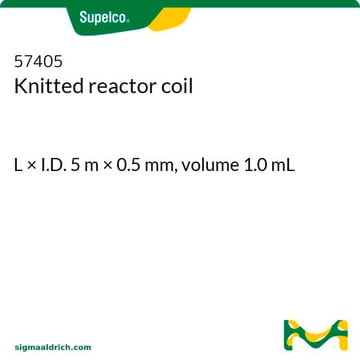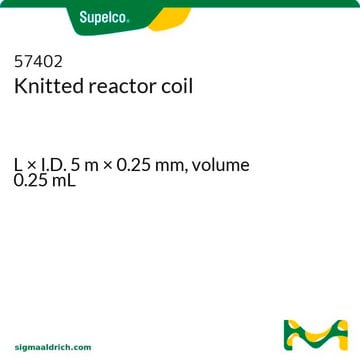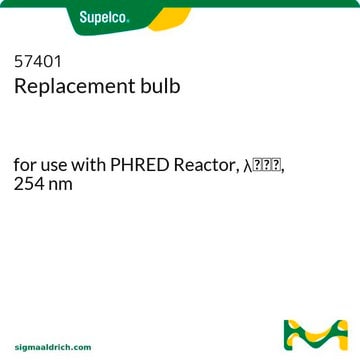57410-U
Knitted reactor coil
L × I.D. 20 m × 0.25 mm, volume 1.0 mL
Synonym(s):
Coiled reactor bundle
Sign Into View Organizational & Contract Pricing
All Photos(1)
About This Item
UNSPSC Code:
41115854
NACRES:
SB.51
Recommended Products
L × I.D.
20 m × 0.25 mm
volume
1.0 mL
compatibility
for use with PHRED Reactor
General description
Knitted reactor coil is used with PHRED photochemical reactor, to determine the duration of exposure to ultraviolet radiation (UV) for the detection of analytes.
Application
- Use of an on-line, precolumn photochemical reactor in high-performance liquid chromatography of naphthodianthrones in Hypericum perforatum preparations.: This study explores the integration of a knitted reactor coil as a precolumn photochemical reactor in HPLC, optimizing the detection of naphthodianthrones in Hypericum perforatum. The results indicate improved sensitivity and specificity in chromatographic analysis (Schmidt, 2003).
- Optimization of post-column photolysis and electrochemical detection for the liquid chromatographic determination of 3-nitro-L-tyrosine.: This research details the optimization of a knitted reactor coil in post-column photolysis and electrochemical detection in HPLC for 3-nitro-L-tyrosine. The findings demonstrate enhanced analytical performance, highlighting the reactor′s role in increasing method sensitivity (Liu et al., 1998).
Storage Class Code
11 - Combustible Solids
WGK
WGK 3
Flash Point(F)
Not applicable
Flash Point(C)
Not applicable
Choose from one of the most recent versions:
Certificates of Analysis (COA)
Lot/Batch Number
Sorry, we don't have COAs for this product available online at this time.
If you need assistance, please contact Customer Support.
Already Own This Product?
Find documentation for the products that you have recently purchased in the Document Library.
Michael Jahn et al.
Pharmaceutical research, 37(6), 118-118 (2020-06-05)
Polysorbates are critical stabilizers in biopharmaceutical protein formulations. However, they may degrade in drug substance (DS) or drug product (DP) during storage. Degradation catalyzed by lipases present in host cell proteins (HCPs) is one suspected root cause. The purpose of
Our team of scientists has experience in all areas of research including Life Science, Material Science, Chemical Synthesis, Chromatography, Analytical and many others.
Contact Technical Service







